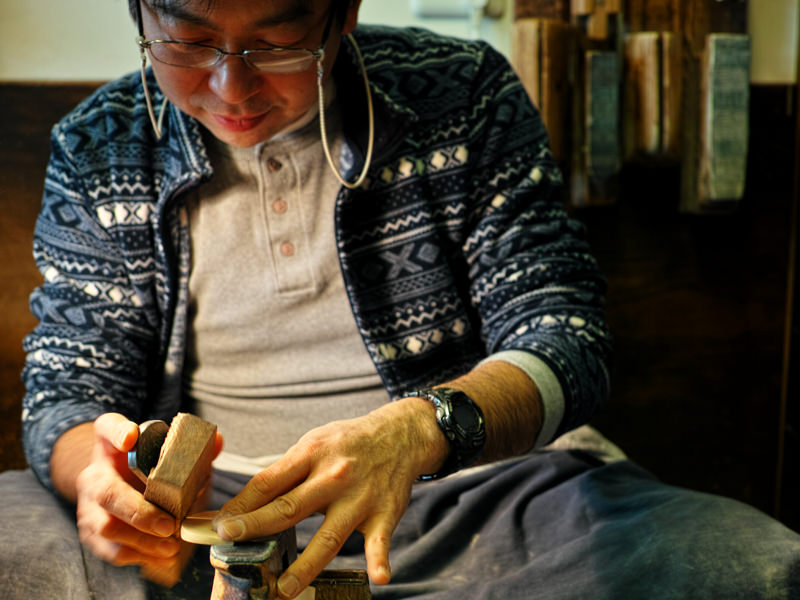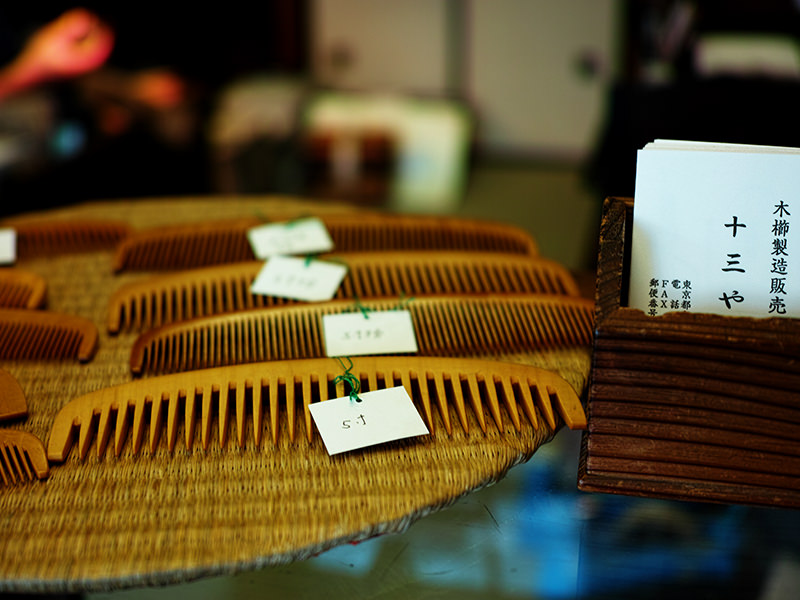Ueno Natives | 上野っ子
竹内敬一
Keiichi Takeuchi


竹内敬一さんは1736年に上野で創業した老舗、十三や櫛店の15代目の店主だ。
昔から黄楊櫛は伝統的な日本髪の女性髪結いたちに愛されてきた。
柘植の木から出来た黄楊櫛は長持ちし、使い続けると髪が健康で艶やかになると言われている。
かつて十三やは北海道を含む東日本全域の髪結いたちとの商売を一手に引き受けていた。
日本全国の老舗櫛屋の中でも十三やの歴史は最も古く、常に東日本の一番店として敬意を払われてきた。
「ここの店主になるにはこの地域で一番の職人じゃなくちゃいけない。親子だからといって当たり前に後を継がせるというものではないんです」竹内さんは言う。
竹内さんは上野の他の子供たちと同じように少年時代を過ごした。
上野商店街のデパートは竹内さんや仲間たちの格好の遊び場だった。
警泥(警察役が泥棒役を追いかけ捕まえる遊び)をするときは泥棒になった子供たちは警察役の子供たちだけでなく、騒がしい子供たちを追い出そうとするデパートの警備員からもうまく逃げなくてはいけなかった。
ある日のこと、竹内さんは友達と塀の上で遊んでいた。
そして塀から飛び降りる際、着地に失敗して思わず地面についた右腕を粉砕骨折してしまう。
近所には当時の関取衆や歌劇団の団員たちも通う治療のうまさで評判の整形外科があったが、そこは法外な治療費でも有名だった。
他に安い病院もあったというが、竹内さんの父親は彼を迷わずその整形外科に連れて行った(結果的に治療費は100万円を超えたという)。
幸い竹内さんの右腕は完治した。
この話をしている間、竹内さんの父親は隣で黙って仕事を続けていた。
当時、父親は竹内さんの職人としての将来をすでに見据えていたのか定かではないが、そのとき父親の愛により救われた竹内さんの右腕が、今日人々が手に入れ得る最高品質の櫛を作り出していることは確かだ。
つげの櫛はいつの時代も美意識の高い日本の女性たちにとって憧れの逸品であった。
竹内さんがかつてのお客さんについて興味深い思い出話しを聞かせてくれた。
その女性は髪結いであった。
彼女がまだ見習いの頃、彼女の師匠が十三やの黄楊櫛を使っているのを見た。
彼女はその櫛をとても気に入り、いつか自分のために一つ手に入れたいと思うようになった。
今もなお日本の徒弟制度というのは厳しい。
彼女の場合、修行期間が10年間、それから3年間のお礼奉公があった。
13年の後、晴れて彼女は一人前の髪結いとなり、長年の夢を果たすために竹内さんの店を訪ねて来たのだという。
この話は、十三や櫛店が老舗の一番店として上野の町にとってだけでなく、工芸品の真の価値を理解する人たちにとっても大切な場所であることを物語っている。
その上野は今、竹内さんの目にどう映っているのか。
「上野にはずっといるけど、記憶の遠くにあるふるさとのような気がする。公園も、池も昔からあるけど、子供の頃に見ていた公園や池とはもう違っているから」
竹内さんが言うように、繁華街・上野は刻一刻とその姿を変え続けてきた。
多様な人々、物、イベント、アイディアなどが日々上野に流れ込んでくるが、上野っ子は自分たちのふるさとがいずれまったく違うものになってしまうかもしれないことが心配ではないのだろうか。
「上野の人って元来おおらかな気風なんです」竹内さんは柔和な笑みを浮かべて言う。
徳川の世から激動の時代を生き残ってきた老舗の後継者だからこそ、その言葉には重みがある。
「僕たちは変化に対して慣れてるから。もしおかしなものや怪しいものが来てもそんなに心配しない。そのうち無くなんじゃない?って思ってるから」
彼の手の中でたった今出来上がったばかりの櫛を見ながら、敬一さんは楽しそうに言った。
Keiichi Takeuchi is the fifteenth head of a historic TSUGE (boxwood) comb shop established in Ueno in 1736.
Since the old times TSUGE combs have been favored by ladies’ hairdressers who do traditional Japanese hair styles.
TSUGE combs are durable, and by using TSUGE combs regularly hair becomes shiny and healthy.
Once Keiichi’s comb shop had been well patronized in a vast area of the entire Eastern Japan including Hokkaido (the northern end of Japan).
Keiichi’s shop has the longest history among long-established quality comb shops in Japan, and it has been always respected as the finest one in the region.
“You must be the best craftsman in the region to be able to succeed to this shop. Blood relationship doesn’t count here,” Keiichi says.
Keiichi spent his childhood just like other boys in his hometown.
Department stores in the Ueno shopping district were his favorite places to play tag with his friends.
Sometimes he needed to hide not only from it, but also from guards of the department stores who tried to throw the noisy kids out.
One day he was playing with his friends on a fence.
When he jumped down from the fence he lost his balance, then he broke his right arm severely by a bad landing.
There was a very good orthopaedic hospital close to his house, but they were famous for their hyper expensive hospital bill.
There might have been other public hospitals that would charge him much less, Keiichi’s father took his son to the expensive one and paid a large amount of the treatment cost (worth around 10,000 dollars today).
Thanks to that Keiichi’s arm recovered completely.
While Keiichi told me this story, his father was sitting right next to him and working silently.
It’s not sure if the father already thought about Keiichi’s future career as a craftsman back then, but that right arm saved by the father’s love now creates the highest quality of TSUGE combs people can get in this time.
TSUGE combs have been always desired objects of Japanese women with an aesthetic sense.
Keiichi told me one interesting story about a woman who bought a comb at his shop before.
She was a ladies’ hairdresser.
When she was an apprentice, she saw her teacher using a TSUGE comb from Keiichi’s shop.
She liked the comb very much, and began to dream of getting one for herself in the future.
Even today, an apprentice system in Japan is quite hard.
In her case, she had worked as an apprentice for ten years, then had worked for extra three years as a token of gratitude for her teacher.
After thirteen years of service she finally became an independent ladies’ hairdresser, and visited Keiichi’s shop to fulfill her long-awaited wish.
This story tells that Keiichi’s shop has been, and is always invaluable to not only the town of Ueno as a historical place, but also people who understand the value of genuine quality of a craft work.
So how does his hometown Ueno seem to Keiichi today?
“Well, I’m always living in Ueno, but it is like my old home where I long for sometimes. Things what I have seen since I was little like a pond, and a park, they are all still here, but today they no longer look like they used to be. So Ueno is my home where I currently live in, and it is also my old home which I miss.”
As Keiichi mentions, this thriving town is changing rapidly from day to day.
A great variety of people, things, events, and ideas are flowing into Ueno daily, doesn’t it make Ueno locals a bit worry about their beloved hometown becoming totally different?
“Ueno locals are traditionally big-hearted.” Keiichi gently smiles and says.
Keiichi’s words carry special weight because he is the successor to the shop which has survived the times of violent change since the samurai era.
“We are quite tolerant toward change. Even if a strange or suspicious thing comes to Ueno, we don’t care too much about it. We say hey, it will be gone soon anyway,” as he looks at a newly-made TSUGE comb in his hand he says merrily.
